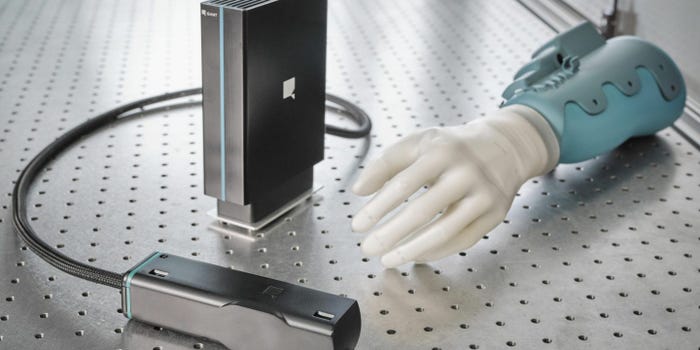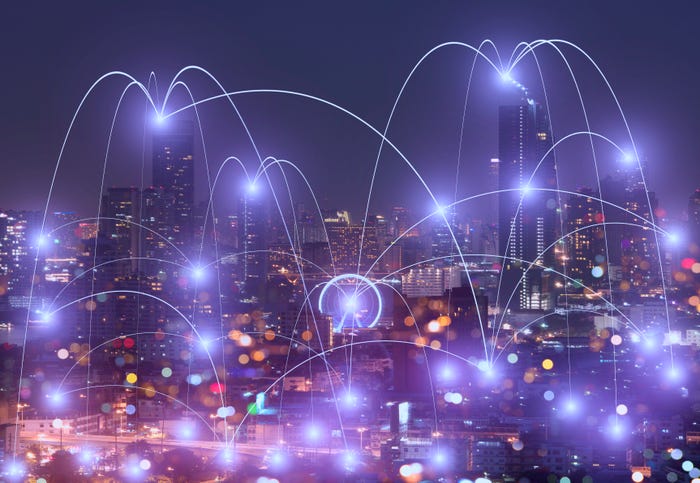With revenue in both the transportation and logistics industries expected to rise significantly in the next six years, IoT sensor data can help them overcome challenges.
April 2, 2019

As IoT coverage continues to grow, the rising amount of data IoT sensors generate and the growing need to act more quickly on data insights is spurring interest in artificial intelligence.
Research firm Tractica, which tracks AI-related revenue by industry, is forecasting that total AI revenue in the transportation industry will rise from $97.3 million this year to $1.25 billion in 2025. AI revenue from logistics industry opportunities (which Tractica forecasts separately from transportation) is expected to reach $1.26 billion by the same year, up from $151.8 million this year.
Feeding and Teaching AI
Companies in the transportation and logistics that want to leverage AI may need to start at a fundamental point of understanding what AI is, what it is capable of, and what it requires on their part to provide the most value for them.
Any enterprises looking to deploy IoT connectivity and architectures have come face-to-face with the reality that IoT is a buzz-laden, overarching acronym suggesting many different things and covering a variety of different technologies and applications. The same is true of AI, which generally involves the concept of rules-driven algorithms processing data, learning from data, deriving insights from data, and perhaps even autonomously acting on that data.
“The goal with AI is to be able to take in information, which may be current parameters or historical data, process that information, and make decisions based on it the same way that humans do,” said Keith Kirkpatrick, principal analyst at research firm Tractica. “Just to be clear, we’re a long way of from being able to do that.” In the meantime, AI-based systems can feed data-fueled insights and recommendations to humans to make better or faster decisions, but first, the AI itself needs to be fed. Enterprises wanting to leverage AI need to have repositories of data that an algorithm designed for a specific application can process, analyze and continue to learn from.
Stephan Biller, vice president of IBM Watson Internet of Things, said IoT networks are instrumental in creating those repositories. “IoT in the end is plumbing,” he said. “You have a platform and you’re taking all kinds of data into that platform, be it from sensors, cameras, from other IT systems. That’s the foundation, and AI without data doesn’t exist, so in some sense the AI sits on top of the IoT, and generates insights.”
Even if companies have existing repositories of data, or deploy infrastructures like IoT networks to generate that data, they still need to deploy AI-based systems and devices to follow sets of weighted rules to deliver relevant recommendations and insights. As AI capabilities are applied to IoT network architectures in the years to come, they will require human training and supervision to provide them with the knowledge of relevant rules and goals tasks.
Tractica’s Kirkpatrick said the evolution toward autonomous vehicles in the logistics sector provides one example of how much an AI system needs to learn. “If you were to think about how truck drivers make decisions on the road, they have a lot of experience driving, so they know when cars cut in front of them how to react. They also know that if they see on Google Maps that there is congestion ahead, they will want to find an alternate route. But, they also have learned that you can’t take trucks on certain side streets because of weight limits. So, there is a huge knowledge repository of rules of the road.”
In addition, when trucks arrive at their destinations on schedule, it helps to keep entire supply chains on schedule. There might even be a financial benefit to the truck driver for arriving ahead of schedule. Part of feeding AI algorithms the data the need is also providing it with rules to follow, and tweaking the algorithm when the AI needs to value a specific rule more highly than a specific desired outcome, Kirkpatrick said.
Human involvement in training and fine-tuning AI algorithms allows companies to make sure unintended results don’t occur. “From taking in years of data on how to get to a particular destination, the algorithm, if unsupervised, may pick up on the idea that it can get the truck to its destination more quickly if it speeds or breaks traffic laws,” Kirkpatrick said. “You can train the algorithm to discard or devalue certain pieces of data in the aiming of meeting its goals.”
While companies undertaking AI projects may be tempted to train their AI systems on their own, Tractica’s Kirkpatrick said it is likely that most firms in specific vertical industries like transportation and logistics will need help from AI specialists.
“Unlike many other technologies, AI needs constant care to provide full value. As such it is very much not a technology you just take out of a box and then forget about,” said Alexander Hoffman, managing director and co-founder of TNX Logistics, which provides an AI platform for third-party logistics companies that helps dispatchers strategically tender their transport jobs to trucking firms. For example, its software-as-a-service is used by New Zealand logistics firm Coda Group to plan jobs across 66 carriers.
“It’s not as if AI needs to rediscover the basics of the transport industry by itself,” Hoffman said. “Humans have vast experience in the industry and have discovered so much more than just a basic understanding of it. The transformative power of AI is to take the very best of that knowledge, insight, and intuition, and make it scalable.”
As AI algorithms become more adept at executing targeted applications, the need for a human touch in training them may lessen, and machine learning — the concept of the machine teaching itself —can take over. For now, some transportation and logistics companies may be uncomfortable with the notion of their AI-enabled systems learning on their own, and eventually making their own decisions, but doing so may help maximize their value to a particular operation.
“If you want a truck to go from one place to another through Manhattan, for example, there are many possible routes,” Kirkpatrick said. “It’s very difficult for a human to look at all the different permutations and figure out the most efficient way to cross Manhattan, given traffic, construction and other factors. The power of machine learning is that you can take in data from all these different crossings and variables, and make instant correlations between all of these data points in a way that humans just can’t do, and even regular data analytics can do.”
Transportation and Logistics Use Cases for AI
Transportation and logistics sectors present AI with a multitude of potential use cases, as they are industries that not only rely on complex machines, but also often follow strict timetables and rely on full capacity usage to achieve maximum value.
In the transportation industry alone, Tractica forecasts AI revenue in seven separate use cases:
Prediction of traffic density.
Predictive maintenance.
Vehicle network and data security.
Sensor data fusion in machinery.
Weather forecasting.
Machine/vehicular object detection/identification/avoidance.
Localization and mapping. In logistics, it also forecasts for the latter three of those use cases, in addition to supply chain and logistics; demand forecasting for warehouse and supply chain; and satellite imagery for geo-analytics.
Among all of these, machine/vehicular object detection/identification/avoidance for the logistics sector, which would cover things like Kirkpatrick’s autonomous trucking example, is anticipated to be the biggest revenue-generating use case area, reaching more than $584 million by 2025. Meanwhile, in transportation, the top use cases are expected to be predicting traffic density and predictive maintenance, with the former home to $439 million in AI revenue by 2025, and the latter reaching $315.2 million by 2025.
Predictive maintenance was central to IBM’s February unveiling of its Maximo Asset Performance Management suite, what it described as a package of IoT solution that leverages AI, to “collect data from physical assets in near real time and provide insights on current operating conditions, predict potential issues, identify problems and offer repair recommendations.” the company said at the time. The Metropolitan Atlanta Rapid Transit Authority already is working
Meanwhile, in logistics, IBM and logistics giant DHL teamed up in 2018 to produce a whitepaper that outlines several potential AI applications in that particular sector. One of those focuses on predictive network management for air freight lanes. DHL created a machine learning-based tool that analyzes 58 different parameters of internal data to predict up to a week in advance if the average daily transit time for a given lane will rise or fall. If air freight planners are able to predict air freight transit time delays, they can proactively attempt to mitigate the expected delays and make more informed decisions about which airlines should carry their freight, DHL said in the white paper.
AI could be applied in similar ways to truck fleet management, IBM’s Biller said. IoT sensors on different parts of a truck could allow AI to assess the truck’s ability to make it from one point to another, and if it’s determined that it won’t, a replacement truck can be readied at a point in between. “If you have no unplanned downtime you can run a much tighter schedule,” he said. “With logistics you really have to focus on the asset and how AI can make that asset more reliable in your operations.”
While such use cases offer great promise to transportation and logistics companies for how AI and IoT together can help improve their operations and processes, change will happen gradually. Kirkpatrick said that as with IoT deployments, many companies in the early stages are deploying AI in isolated fashion. “It’s not like getting new IBM computers and trying them out in accounting and than getting them for everyone else if they work well,” he said. “With AI, you really need a different algorithm for every use case, and you have to make sure for each use case you can generate ROI.” Kirkpatrick said many AI technology vendors he spoke with said it still takes a long time to get enterprise and industrial customers to move past the proof-of-concept stage.
That may change as more companies deploy more extensive IoT networks that generate more data needing real-time attention. AI systems will be able to analyze more data much faster than any human or group of humans can, but companies deploying AI still must accept the notion that they essentially will be implementing technology that may be nowhere near as effective and valuable for them at the outset as it will become over time.
“It’s a revolution where we don’t see all the benefits yet,” IBM’s Biller said. “but they are coming.”
About the Author(s)
You May Also Like


.png?width=700&auto=webp&quality=80&disable=upscale)
.png?width=300&auto=webp&quality=80&disable=upscale)


.png?width=300&auto=webp&quality=80&disable=upscale)